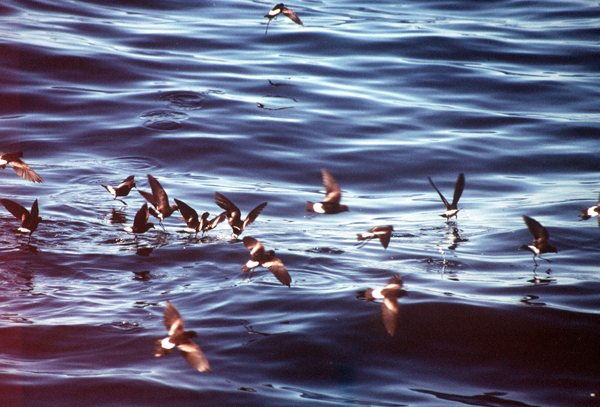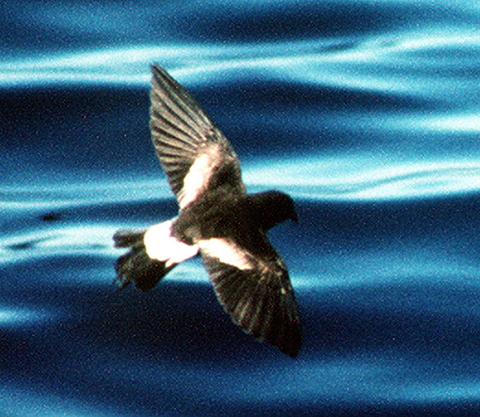| Wilson's Storm-Petrel
Oceanites oceanicus PaŪŮo de Wilson,
|
 |
|
Photo: B. Hallett
|
|
IDENTIFICATION: A small, dark brown seabird with a prominent white rump patch. Length: 15-19 cm.; weight: 34-35 g. VOICE: A variety of purring notes and groans are given on the breeding grounds; generally silent on migration. HABITAT: Open ocean, especially over waters with abundant plankton. HABITS: One of the Spanish names for this species is "Golondrina de Mar" or sea swallow---a very appropriate name. Like a swallow, the Storm-Petrel rapidly darts back and forth across the ocean in search of food close to the surface. It often faces into the wind, holds its wings in a "V", dangling its legs, and seeming to walk on water. It travels in flocks, and feeds on small marine crustaceans (especially krill), squid, other invertebrates, and fish. One theory is that the Storm-Petrel homes in on the chemical dimethyl sulfide which is released when krill graze on plankton. It often follows whales and fishing boats, and can detect food by smell. This Storm-Petrel breeds in huge colonies on islands near Antarctica, where it builds a nest in a burrow or crack in the rocks. It lays one egg per season, and both sexes alternate incubating the egg in 2-day shifts for about 43 days. The chicks are initially fed a paste of partially-digested fish and crustaceans, and fledge about 60 days after hatching. This species spends much of its life at sea, and has well-developed salt glands that allow it to efficiently eliminate excess salts. After the chicks fledge in April, Wilsonís Storm-Petrel migrates from southern oceans, across the Equator, to the oceans of the northern hemisphere. Some birds follow a clockwise path around the North Atlantic passing west of Europe before heading back to Antarctica. Storm-Petrels donít breed until 2-4 years of age. STATUS AND CONSERVATION: A rare species in the Caribbean in late spring, as it migrates from Antarctica to cold, productive waters of the North Atlantic. But it may be commoner than reported, since few birders spend much time on the open oceans of the West Indies. Its worldwide population probably numbers several million breeding pairs. However, the recent, massive commercial harvest of krill in Antarctic waters may eventually reduce its numbers. RANGE: Breeds on Antarctic and sub-Antarctic islands. Wanders widely, especially over the north Atlantic and Indian Oceans. TAXONOMY: PROCELLARIIFORMES; HYDROBATIDAE |
|
 |
|
|
Photo: B. Hallett
|

